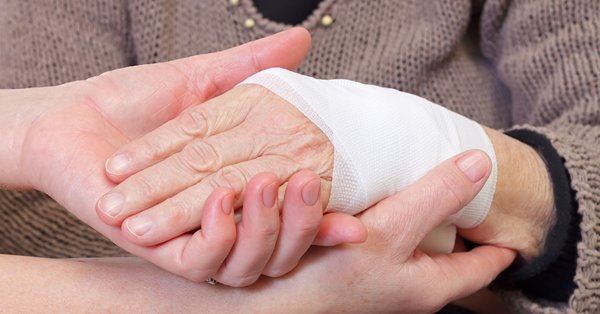 When you think about caring for a loved one with diabetes, what do you have to consider every day? Of course, blood sugar levels, medication management, and diet top the list. But burn safety should be a high priority as well.
When you think about caring for a loved one with diabetes, what do you have to consider every day? Of course, blood sugar levels, medication management, and diet top the list. But burn safety should be a high priority as well.
But burns aren’t just caused by heat — cold burns and chemical burns can be just as dangerous. The risk is higher for persons with diabetes, and without treatment, any type of burn can possibly:
- Blister
- Develop into an open wound
- Become infected
- Lead to amputation
Let’s review the burn risks people with diabetes face, how to help your loved one avoid them, and how a BrightStar Care nurse can help.
Thermal Burns
A thermal burn is the type most people think of and is caused when the skin makes contact with heat. Common culprits include:
- Fire
- Heating pads
- Hot pots or pans
- Hot water or oil
- Steam
Fireplaces and kitchen appliances are obvious heat sources that can cause burns. However, electric heating pads are one of the major culprits of burns among people with diabetes. In fact, injuries are so common that we recommend that none of our clients with diabetes use heating pads. Older adults’ skin tends to thin with age and is more prone to injury with diabetes. Coupled with reduced sensitivity from diabetic neuropathy, a heating pad turned up too hot easily can burn a senior’s sensitive skin.
If your loved one insists on using heat to relieve pain, try to discourage this. If they still insist, help them prepare it to a temperature of moderate heat. Never microwave or use a hot water bottle as those can increase the risk of scalding the skin.
Cold Burns
People often focus on heat sources when they think about burns, but cold can be just as dangerous. The most commonly known cold burn injury is frostbite, which is a particular concern for people with diabetes because of neuropathy and decreased blood circulation.
Skin that’s in contact with snow, ice, or even cold air for long periods is at great risk for frostbite. Snow or ice on the ground increases the risk your loved one may fall and expose themselves to prolonged contact with those elements. One study found that elderly people who have diabetes were twice as likely to fall as those without diabetes regardless of the time of year.
Related reading: 7 Ways You Can Help Your Loved One After a Fall
To avoid frostbite, always make sure your loved one is dressed appropriately for cold temperatures, even if it’s just for a few minutes. Their winter weather wear should include:
- Boots or shoes with socks, not slippers
- Coat or heavy jacket
- Gloves
- Hat
Chemical Burns
Chemical burns are particularly hazardous for older adults, especially those with diabetes. Many types of common home cleaning products can cause chemical burns, such as:
- Ammonia
- Bleach
- Toilet bowl cleaners
If your loved one has memory or cognitive issues, consider locking up or removing these potentially dangerous products from the home. A BrightStar Care nurse can conduct a home safety assessment, and a professional caregiver can help with cleaning to reduce this risk.
However, it’s not just cleaning agents that can put your loved one at risk for a painful chemical burn. People with diabetes are in jeopardy if they use products that contain capsaicin, the substance that makes chili peppers spicy. Products containing capsaicin often are used to relieve pain from a number of conditions, such as:
- Arthritis
- Muscle aches, strains, and sprains
- Neuralgia, a type of nerve pain caused by shingles and other diseases
If your loved one has diabetes, be particularly mindful of products that contain capsaicin. The skin may have cracks that aren’t visible to the naked eye, and topical creams or ointments with capsaicin can cause a painful burning sensation if they’re applied to an open wound.
Call 911 right away if your loved one has a serious burn, or take them to the emergency room. In the home, our nurses follow the National Patient Safety Goals for home care, which include specific safety protocols. We’re accredited by the Joint Commission, and our nurses conduct home safety evaluations as part of our personalized approach to caring for your loved one. Burns might not be top of mind for diabetes care, but they’re a risk our caregivers are trained to assess and reduce.
Call 866-618-7827 or contact a BrightStar Care home care agency near you to learn more about our in-home care services for your loved one.
